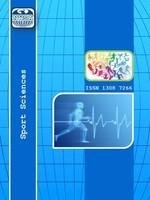15 YAS ALTI KIZ VE ERKEK BADMINTONCULARININ FIZIKSEL UYGUNLUKLARININ KARSILASTIRILMASI
Bu arastirmanin amaci, 15 yas alti kiz ve erkek badmintoncularinin fiziksel uygunluklarini karsilastirmaktir. Denek grubunu Bursa'dan 14 erkek (13.8±1.7 yil) ve 13 kiz (13.2±1.7 yil) badminton oyuncusu olusturdu. Deneklerin fiziksel uygunluklarini belirlemek için boy ve agirlik ölçümü, BMI hesaplanmasi ile dikey siçrama, shuttle run, isik ve ses reaksiyon zamani, otur&eris, running-based anaerobik sprint, durarak uzun atlama ve yön degistirme testleri uygulandi. Elde edilen bulgularinin degerlendirilmesi "Independent - Samples T" testi ile yapildi. Erkek ve kiz badmintoncular arasinda durarak uzun atlama (193.9±28.6 cm; 156.7±21.2 cm), Max VO2 (42.4±5.6 ml/kg/dk; 33.2±5.5 ml/kg/dk), 35 m sprint (5.61±0.39 sn; 6.69±0.49 sn), anaerobik kapasite (357.1±146.8 watt; 174.5±49.4 watt), yorgunluk indeksi (9.8±4.1 watt/sec; 4.4±1.5 watts/sec), minimum güç (273.2±123.9 watt; 123.5±43.1 watt), maksimum güç (624.5±242.5 watt; 313.5±79.7 watt) ve beceri (6±0.3 sn; 7.1±0.7 sn) degiskenlerinde istatistiksel olarak anlamli fark tespit edildi (p
Anahtar Kelimeler:
BADMINTON, FIZIKSEL, PERFORMANS, , , , , , ,
THE COMPARISON OF PHYSICAL FITNESS OF FEMALE AND MALE BADMINTON PLAYERS UNDER 15 YEARS
The aim of this study was the comparison of physical fitness of female and male badminton players under 15 years. The subject group consist of 14 male (13.8±1.7 years) and 13 female (13.2±1.7 years) from Bursa. To determine physical fitness of subjects weight and height were measured, BMI was calculated and shuttle run, visual and audial reaction time, sit & reach, running-based anaerobic sprint, standing long jump and lateral change of direction tests were applied. The results from this study were evaluated by Independent – Samples T test Between male and female badminton players respectively standing long jump (193.9±28.6 cm; 156.7±21.2 cm), max VO2 (42.4±5.6 ml/kg/min; 33.2±5.5 ml/kg/min), 35 m sprint (5.61±0.39 sec; 6.69±0.49 sec), anaerobic power (357.1±146.8 watt; 174.5±49.4 watt), fatigue index (9.8±4.1 watt/sec; 4.4±1.5 watts/sec), minimum power (273.2±123.9 watt; 123.5±43.1 watt), maximum power (624.5±242.5 watt; 313.5±79.7 watt) and agility (6±0.3 sec; 7.1±0.7 sec) variables were determined statistically significant difference (p
Keywords:
Badminton, Physical, Performance, , , , , , , ,
- Başlangıç: 2009
- Yayıncı: E-Journal of New World Sciences Academy
Sayıdaki Diğer Makaleler
15 YAS ALTI KIZ VE ERKEK BADMINTONCULARININ FIZIKSEL UYGUNLUKLARININ KARSILASTIRILMASI
